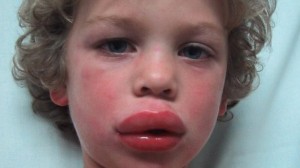So you know the puffy lips I am talking about? And I don’t mean Angelina Joelle’s!!
An allergy is an overreaction by the body’s immune system to a normally harmless substance. Substances that can trigger an allergic reaction are called allergens. Allergens that can trigger an allergic reaction are in medication, the environment like pollens, cats, dogs, grasses, moulds or sometimes in the food we eat. Individuals can have mild allergies or severe allergies.
Many more Australian children and adults are being affected by allergies. The most common allergic conditions are food allergies, eczema, asthma and hay fever.
An allergic reaction can be experienced in various ways:
- Food allergy
- Food intolerance
- Eosinophilic esophagitis
- Oral Allergy Syndrome (OAS)
- Anaphylaxis
Next week’s blogs I will explain more about the reactions in detail. Because there is so much to share with you regarding allergens I will blog over the next couple of weeks.



This is exactly what happens, not very sightly. Try being this person or family member watching this happen. I have had this happen to my 8 year old son and I know how it made me feel. We did not find out what caused it but it was one of the scariest moments in my life.
I have learnt with allergens that if you, a family member or close friends don’t have an allergy it does not seem to resonate with others. If you feel the pain, the agony and the stresses you know how scary it is and how hard it is living with an allergy.
If you don’t inject insulin into your stomach 4 to 6 times a day you don’t know how tough it is having millions of tiny holes in your stomach and watching everything you eat but a diabetic sure does. Every crumb, every ounce of food or liquid entering their body is measured and assessed.
I really want to stress the point that we need to put ourselves in our consumer’s shoes and think what it is like for them and how serious allergens are. For some it only takes one bite to cause a fatality.
We are responsible for what we sell so let’s not doubt for a minute it’s ok we are doing the right thing. Be sure, be confident, know your processes and policies inside and out relating to allergen controls and management and know your associates are complying. Don’t wait for a consumer to let you know you are not in control.
So what can food handlers, food and beverage manufacturers do to prevent consumers suffering from an allergic reaction?
To prevent allergic reactions occurring with consumers we need to be due diligent and take every reasonable precaution to implement allergen controls and manage them to prevent cross contact of allergen raw materials, equipment, tools or finished product.
Cross-contact occurs when an allergenic food touches another food or surface, conveyors, bins, bowls, hoists, pipes, fillers, tanks, shelves, tools, utensils, grills, blenders, food processors, trays, benches, countertop, tables, plates, or someone’s hand. Cross-contact is the primary vehicle of accidental exposure to food allergens. To avoid cross-contact we need to apply controls and monitor food preparation, handling, manufacturing, packing, storage, distribution and serving methods.
Working in manufacturing facilities you become aware of commercial reality and processes that need to be controlled and managed. As quality and food safety professionals it is our responsibility to ensure we implement and enforce safe food practices to prevent consumers being hurt, made ill or harmed in any way. Corrective and preventive actions must be instigated, completed and evident to prove we are in control and ensuring food quality & safety at all times.
My background has given me an opportunity to learn as leaders in Australian manufacturing we must encourage each other to establish robust, effective and successfully proven quality management systems and HACCP plans. Our consumers want to trust that we are always in control and can guarantee safe good tasting products.
Numerous diligent actions can be taken to prevent consumer allergic reactions such as:
- Establishing manufacturing or food preparation flows & scheduling
- Labelling & colour coding
- Risk assessments
- Training and raising awareness
- Documenting policies and procedures
- Rework, WIP & change over policies
- Separation and segregation
- Validations and verification
- Uniform management
- Spillage clean up policies and procedures
- Employee work flow and restrictive areas
- Inductions for visitors, contractors and new employees
- Cleaning schedules and cleaning procedures
- Packaging labelling
- Product Information Form (PIF)
- Voluntary Incidental Trace Allergen Labelling (VITAL)
- Use of vinyl disposable gloves rather than latex
- Protocols for 3rd party manufacturers and co-packers
- Vendor Assurance
- Product testing and equipment swab tests
- NPD protocols and procedures
- Raw material management (purchase, receival, testing, store, handle, usage)
- Product specifications
- Seek advice or assistance from industry professionals, utilise experts that are available in the food industry to assist you
I hope our blog from Elevating Food Safety Pty Ltd resonates with you and motivates you to be sure, confident, and compliant at all times.
Keep checking and keep training, yours in passion, Dijana Green.



















Get Social